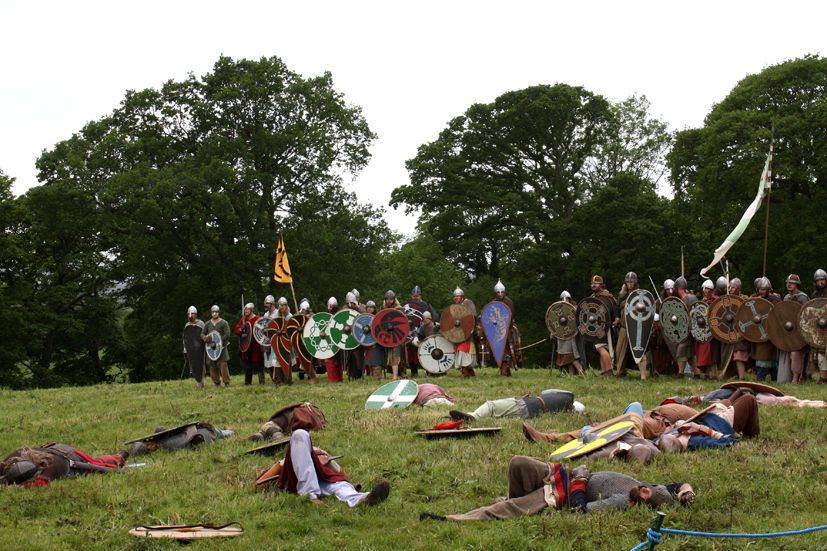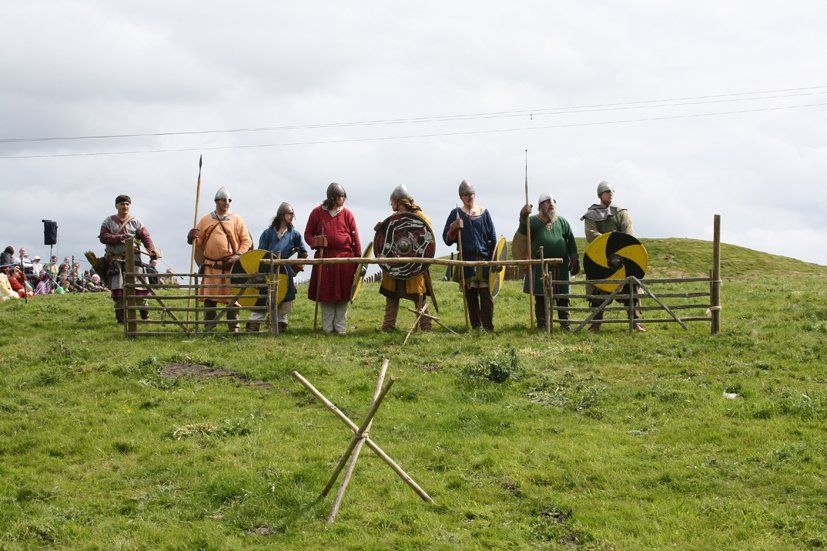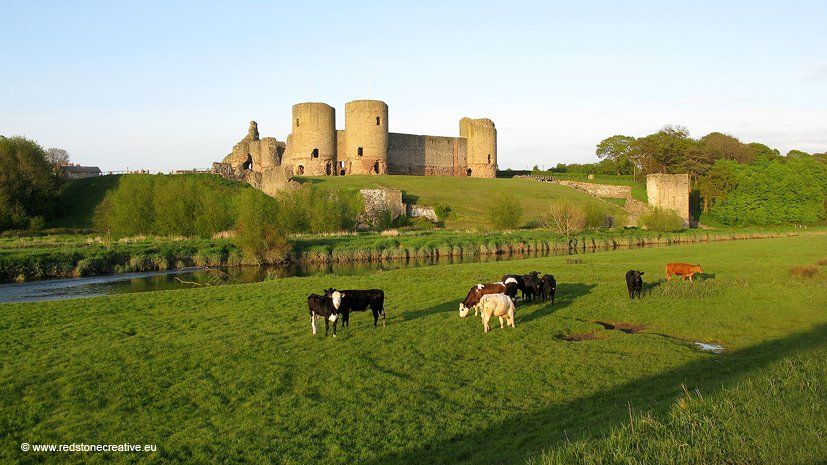Rhuddlan Timeline
A Walk Through History

Early History
Rhuddlan first appeared in recorded history in the last years of the eighth century, when there was no town of Rhyl and the shore road from Prestatyn to Abergele did not exist.
Instead, the Clwyd and the marshes off its estuary, now reclaimed and drained and cultivated, formed a natural barrier athwart the coastal approach to the mountainous heart of North Wales.
The settlement of Rhuddlan is likely to have owed its origin to the presence at this point, from very early times, of the lowest fording place on the river, from which a track led across the marsh to Vaynol and beyond. Its position thus marked it out as a key point in the racial struggles which for some 600 years (c.700-c.1300) swayed to and fro across the Welsh and English border.
During the reign of King Offa of Mercia (757-96) the great dyke which bears his name (right) was constructed, outlining the beginning of the hill country from Prestatyn to the Bristol Channel and defining the westward limit of English settlement. In 796, the year of Offa's death, the English fighting on beyond the new frontier won a battle at Rhuddlan, and either as a result of it or of a later conquest obtained control of Englefield.
The district, the Welsh Tegeingl, preserves in its name the memory of the Deceangli, a Celtic tribe mentioned by the Roman historian Tacitus in the first century of the Christian era. By the time of the coming of the Normans Englefield was restricted to the northern part of the later Flintshire and was dependent on Rhuddlan.
Further English operations on the northern frontier are indicated by the death of Offa's successor, Cenwulf, at Basingwerk in 821. The predominately Welsh place-names to the west of Offa's Dyke suggest, however, that Rhuddlan and its outlying manors were not firmly consolidated under English rule.
A century later, in the year 921, King Alfred's son Edward the Elder (d.924) established an earth and timber fort or burh at the mouth of the Clwyd, as part of his defence of the north Wales and Cheshire coastlines against Scandinavian raids.
It has been suggested that King Edward's fort was sited close to Rhuddlan itself and that the banks and ditches which can be traced on the south-east outskirts of the town may have formed part of its earthworks: but this remains uncertain, and it seems more likely that the burh stood close to the river's mouth at a place on the coast now lost, but still known in 1310 as 'Bircloyt'.
We next hear of Rhuddlan in 1063, it is a royal seat of Gruffydd ap Llywelyn and the base from which that powerful prince (actually considered the last true High King of Wales) plundered the English lands as far east as Oswestry and Wrexham.
In that year Gruffydd was driven from Rhuddlan by Earl Harold (Godwinson) and his palace burned.

The Norman Conquest
Three years later Harold himself lost the decisive battle of Hastings, and the Welsh had henceforth to contend with the organized might of the most powerful military despotism in Europe.
At the command, William the Conqueror, a new castle of the motte-and-bailey pattern, which marked every stage of the Norman penetration, was thrown up at Rhuddlan in 1073 by Robert of Rhuddlan, a kinsman, and lieutenant of Hugh d'Avaranches, earl of Chester.
Earlier, in the 1050s, Robert had been a squire at the court of King Edward the Confessor, by whom he had been knighted.
From the Domesday book (1086) we learn that in return for an annual rent of L40, the Conqueror had granted him power over the whole of North Wales beyond the Clwyd; it was in this capacity that Robert made Rhuddlan the base from which he set out to exploit and consolidate the holding entrusted to him by the king in Gwynedd, and from which he also took his surname.
He was, as other sources show, one of the lords of first importance in the Conqueror's ruling councils.
More interestingly, we know on good authority that it was Robert's father, Humphrey of Tilleul, who was put in charge of the construction of the motte at Hastings, seen in progress in the Bayeau Tapestry, immediately after the Normans landed at Pevensey in 1066.
Even to this day, Robert's earthen mound traditionally occupying the site of Gruffydd ap Llywelyn's palace, rises impressively to the south of its 13-century successor, while the outline of its bailey may still be traced in the adjoining fields.
From Doomesday we also learn that under the lordship of Robert and earl Hugh, a small borough was established beside the castle.
In 1086 its burgesses, 18 in number, had both a church and a mint and enjoyed privileges and immunities conferred by the laws and customs of Hereford.
Silver pennies minted at Rhuddlan late in the reign of the Conqueror and again from c.1180 to 1215 are preserved in museum collections.

The 12th & 13th Centuries
During the following two centuries, the castle and town changed hands many times, as the tide of border warfare favoured first the Welsh and then the English.
We know little of the development of the castle buildings during these years. A late as 1241-42, the defences, at least in part, were still of wood, and timber-framed buildings occupied the bailey.
There is a record in that year of payments for timber to repair the defects in the wooden works, for making cranes, ladders, and other necessary implements, and for carrying old wooden works back to Chester; orders are given at the same time for the construction of a wooden chapel in the castle where divine service may be celebrated.
By now the age-old border struggle was about to enter its last phase, a phase in which Rhuddlan was to assume a new and increased importance.
During the reign of Henry III, political disunity in England gave Llywelyn ap Gruffydd an opportunity to establish his authority over all the lesser princes of his country. Assuming the title 'Prince of Wales', he won recognition first from the baron's leader Simon de Montfort, and in 1267 from King Henry himself.
Llywelyn's fall, as Sir John Lloyd has written, was as spectacular as his rise.
Thinking in terms of the Baron's War, he failed to realize the new unity achieved under Edward I and directly challenged that monarch's power.